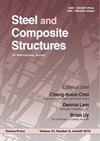不同荷载作用下钢筋混凝土扩横柱的抗震性能
IF 3.9
3区 工程技术
Q1 CONSTRUCTION & BUILDING TECHNOLOGY
引用次数: 1
摘要
基于有限元软件,采用模拟程序对新型钢筋混凝土(SRC)柱的抗震性能进行了评价,即扩大交叉钢筋混凝土(ECSRC)柱。通过大量的模拟,研究了加载路径、加载循环次数、位移增量幅值和变轴荷载对ECSRC柱地震响应的影响。结果表明,柱的抗震性能高度依赖于加载路径,并且观察到加载路径对柱的滞后响应产生显著影响。与单轴作用下相比,双轴作用下ECSRC柱的屈服荷载、最大荷载、极限位移和延性系数分别降低了13.47%、18.01%、12.17%和32.64%。柱的耗能能力与荷载路径密切相关。在达到钢筋和纵筋屈服点之前,骨架曲线不受加载次数的显著影响。随着加载循环次数的增加,柱的屈服荷载、屈服位移、延性系数和最大荷载以及相应的水平位移减小,而耗能增大。屈服位移、屈服荷载和延性系数随位移增量幅值的增大而增大;然而,在这些条件下,能量耗散减小。在变轴向荷载作用下,SRC柱的抗震性能表现出明显的不对称性,这种不对称性比恒轴向荷载作用下的不对称性更差。本文章由计算机程序翻译,如有差异,请以英文原文为准。
Seismic behaviour of enlarged cross steel-reinforced concrete columns under various loadings
Based on finite element software, a simulation programme is used to evaluate the seismic behaviour of new-type steel-reinforced concrete (SRC) columns, called enlarged cross steel-reinforced concrete (ECSRC) columns. With abundant simulations, the effects of the loading paths, number of loading cycles, incremental amplitude of displacement and variable axial load on the seismic response of the ECSRC columns were investigated. The results indicate that the seismic behaviour of the column is highly dependent on the loading paths, and it was observed that the loading paths produced a significant effect on the hysteretic response of the columns. Compared with those under uniaxial loading, the yield load, maximum load, ultimate displacement and ductility coefficient of the ECSRC columns under biaxial loading are reduced by 13.47%, 18.01%, 12.17% and 32.64%, respectively. The energy dissipation capacity of the columns is highly dependent on the loading paths. The skeleton curves are not significantly influenced by the number of loading cycles until the yield point of steel and longitudinal reinforcement is reached. With an increase in loading cycles, the yield load, yield displacement, ductility coefficient and maximum load, as well as the corresponding horizontal displacement of the column, are reduced, while the energy dissipation grows. In addition, the yield displacement, yield load, and ductility coefficient increase with an increase in the incremental amplitude of displacement; however, the energy dissipation decreases under these conditions. The seismic performance of the SRC column under variable axial loads clearly exhibits asymmetry that is worse than that observed under constant axial loads.
求助全文
通过发布文献求助,成功后即可免费获取论文全文。
去求助
来源期刊

Steel and Composite Structures
工程技术-材料科学:复合
CiteScore
8.50
自引率
19.60%
发文量
0
审稿时长
7.5 months
期刊介绍:
Steel & Composite Structures, An International Journal, provides and excellent publication channel which reports the up-to-date research developments in the steel structures and steel-concrete composite structures, and FRP plated structures from the international steel community. The research results reported in this journal address all the aspects of theoretical and experimental research, including Buckling/Stability, Fatigue/Fracture, Fire Performance, Connections, Frames/Bridges, Plates/Shells, Composite Structural Components, Hybrid Structures, Fabrication/Maintenance, Design Codes, Dynamics/Vibrations, Nonferrous Metal Structures, Non-metalic plates, Analytical Methods.
The Journal specially wishes to bridge the gap between the theoretical developments and practical applications for the benefits of both academic researchers and practicing engineers. In this light, contributions from the practicing engineers are especially welcome.
 求助内容:
求助内容: 应助结果提醒方式:
应助结果提醒方式:


